Did you ever see someone spread sand on the lawn? If yes, I am sure you were thinking about its reason. Maybe, you are here because you want to know about the benefits of using sand on the lawn. Basically, there is a big controversy about sand for lawns. At the same time, some people prefer it while some don’t.
To say it in one sentence, it is good for your lawn only if you can use it properly. But it has a lot of disadvantageous sides too. So, if you wish to spread sand on your lawn, you should learn about it first.
And that’s why I am here today. I planned to have a complete discussion on the sand for the lawn. Today, we will learn every good and bad side of using sand on the lawn. And then, if you want to use it, I will tell you how to spread sand on your lawn properly.
Is Sand Good for Your Lawn?
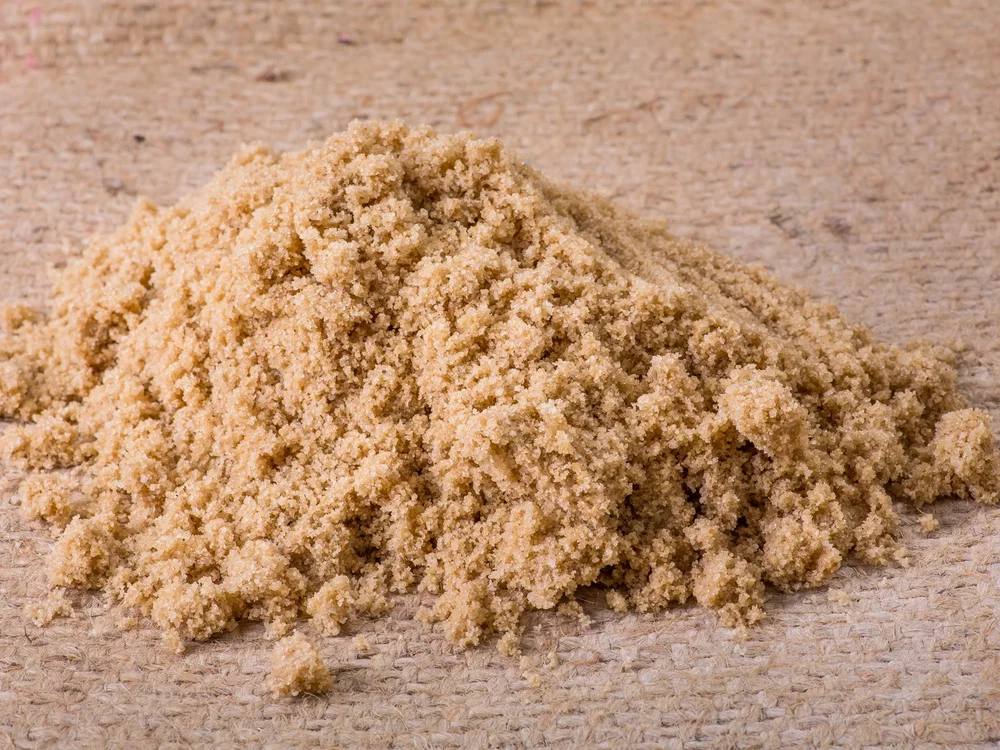 First, we should learn whether it is good for your lawn or not. Let’s start with what Science says. Studies show that top-dressing lawn with sand is more helpful only if you can use it properly. The reason is most of the time; people can’t use sand properly on the lawn. In the end, the sand globs up throughout the lawn, and the grass beneath the sand gets choked. The main purpose of using sand on lawns is to control the build-up of thatch.
First, we should learn whether it is good for your lawn or not. Let’s start with what Science says. Studies show that top-dressing lawn with sand is more helpful only if you can use it properly. The reason is most of the time; people can’t use sand properly on the lawn. In the end, the sand globs up throughout the lawn, and the grass beneath the sand gets choked. The main purpose of using sand on lawns is to control the build-up of thatch.
Sand is mainly used in Golf courses to maintain the even and clean top dressing. Golf courses are built of sandy soil and have special turf grass that can tolerate the sandy conditions when sand is used. However, our domestic lawn is different. Our domestic lawn needs rich, finest compost instead of sand. Plus, golf courses receive much more maintenance than normal lawns.
Therefore, you can use sand on your lawn evenly and with thin layers so it doesn’t gobble up in the future. Plus, if your lawn has any holes or bumps, that will be fixed automatically when you will use sand. In addition, to prevent thatch from growing, you can use sand. Before using sand in your lawn, remember to fertilize the lawn very well. It’ll allow the grass to grow stronger and fight against the changes of sand.
As we see, it has both advantages and disadvantages for your lawn. It can be deadly if you don’t use it in the right way. On the contrary, it can be more fruitful than fertilizer if you manage to use it properly. However, let’s first check out the advantages and disadvantages of using sand on your lawn.
Advantages of Using Sand On Your Lawn
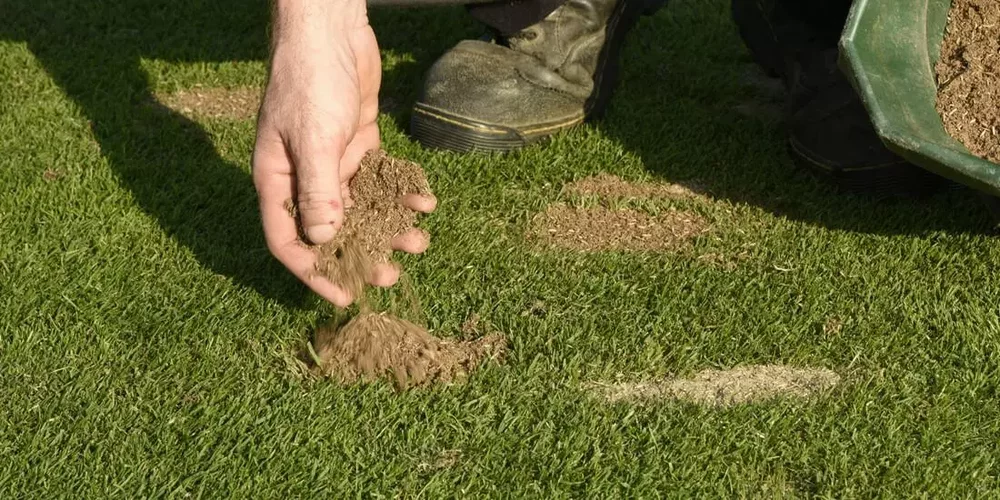 If you can spread sand in your lawn evenly, then it can help your soil and grass rather than hampering it. There are indeed lots of benefits to using sand as topsoil for your lawn. Let’s see the benefits we can get from using sand in lawns.
If you can spread sand in your lawn evenly, then it can help your soil and grass rather than hampering it. There are indeed lots of benefits to using sand as topsoil for your lawn. Let’s see the benefits we can get from using sand in lawns.
1. Improves Firmness of Soil
A thin layer of sand on the lawn can improve the firmness of the soil. If your soil seems a little spongy, it’s probably because of using excessive fertilizers and organic materials. It ferments the soil and enhances the insects on the topsoil. To control this situation, you can use sand to firm and strengthen the spongy soil. In this case, you have to spread sand on the lawn firmly as the topsoil.
2. Improvement of Water Drainage
Drainage systems of the lawn ground are very crucial parts of growing a healthy and green lawn. Sand can help here too. Compact, spongy, squishy soil is harmful because it can’t let the water circulate properly.
As a result, it destroys the aeration system of the grassroots. Sand can help in this case by improving the drainage system. It makes places in compact soil for water circulation; thus, the roots can get sufficient water.
3. Protects Grass
Sand helps to grow your grass faster and improves the recovery rate. When there is lots of traffic of people on the lawn, sand comes in handy to prevent the grass from being damaged. When you use sand as the topsoil, it works as the guard for the grass. As a result, it will save the grassroots when the place has excessive traffic.
4. Create Smooth Look
To improve the firmness of your lawn, you can use Sad as the topsoil. Generally, sand can fill the gaps and holes in the soil, leaves, and steam. That creates a very smooth and clean look. So, sand can be a perfect solution if your lawn doesn’t have a smooth surface.
5. Controls The Growth of Thatch and Moss
Some turf grass has issues with thatches and moss. Excessive thatch and moss are always harmful to your lawn. If your lawn has such a problem, using sand is the perfect way to get rid of it. A very thin layer of sand on the lawn reduces the growth of weeds, moss, and thatches.
Besides, river sand has lots of unique beneficial sides for your lawn. While preparing the soil for a new lawn, you can use sand for a better result. It ensures better soil drainage and improves the growth of the grass. In some cases, sand is helpful in reducing the growth of some weeds too.
Disadvantages of Using Sand on The Lawn
 Though there are tons of benefits to using sand, you can’t use them at any time. Remember that there are lots of disadvantages to using sand on your lawn. It happens, especially when you are not using it properly. However, before we learn how to use sand on the lawn, let’s check out its dark sides.
Though there are tons of benefits to using sand, you can’t use them at any time. Remember that there are lots of disadvantages to using sand on your lawn. It happens, especially when you are not using it properly. However, before we learn how to use sand on the lawn, let’s check out its dark sides.
- Sand doesn’t have any nutrition for the soil, so it won’t be of any benefit to the soil. Rather, if not spread properly, it can prevent the grass from getting enough nutrition.
- If not applying the sand evenly on the lawn, it can pile up and choke the grass.
- Applying sand as a top dressing in a very thin layer is recommended. Like, a two-inch layer is better. If it is thick, then it can kill grassroots.
- NEVER use sand on clay soil. It’ll be suffocating for grass as it’ll create a cement-like texture.
- Make sure the sand you’re using is clean and free from any seeds or weeds. Otherwise, your lawn gets to be full of weeds within a few weeks.
As we see, sand is not suitable for clay soil. So, skip reading this article if you have a lawn with clay soil. If not, using sand is useful. But you have to ensure that you use a very thin layer of sand on the lawn and that the sand is clean. It will be better if you sieve the sand to make sure that it has no seeds or insects.
Best Time to Use Sand on the Lawn
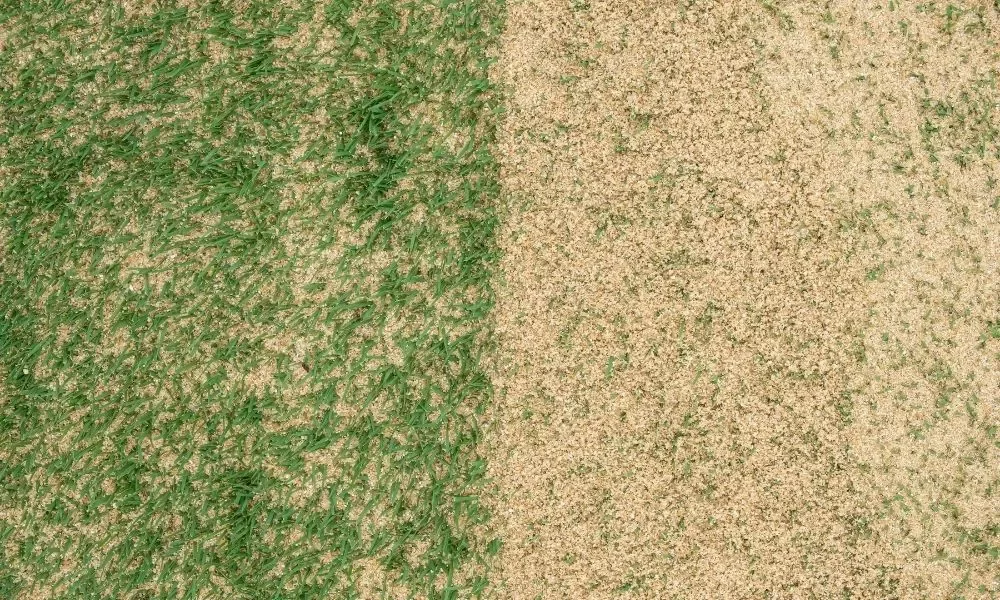 The only way to use sand on your lawn is to use it as a top dressing. But you cannot use sand as the top dressing on your lawn at any time. There is a specific time when your lawn needs it. So, before we learn how to use it on the lawn, let’s check out when we should use it. Let’s see when we should and shouldn’t top dress sand on the lawn.
The only way to use sand on your lawn is to use it as a top dressing. But you cannot use sand as the top dressing on your lawn at any time. There is a specific time when your lawn needs it. So, before we learn how to use it on the lawn, let’s check out when we should use it. Let’s see when we should and shouldn’t top dress sand on the lawn.
Sand works better if it’s applied every 4-6 weeks throughout the entire late spring and summer. Regular use of sand at this time can reduce the growth of moss, weeds, and thatch. However, remember not to overuse the sand and spread it evenly on the lawn. Therefore, autumn, spring, and summer is the best time to use sand on the lawn.
Make sure to use sand on your lawn on a dry day or weather. You shouldn’t choose a time when it’s not raining. You shouldn’t use sand on any rainy day because wet granules of sand can form clumps and cause small bumps. It’s also not recommended to use sand in this winter season too. Otherwise, winter will dampen the layer of sand and choke the grass.
How to Apply Sand on the Lawn?
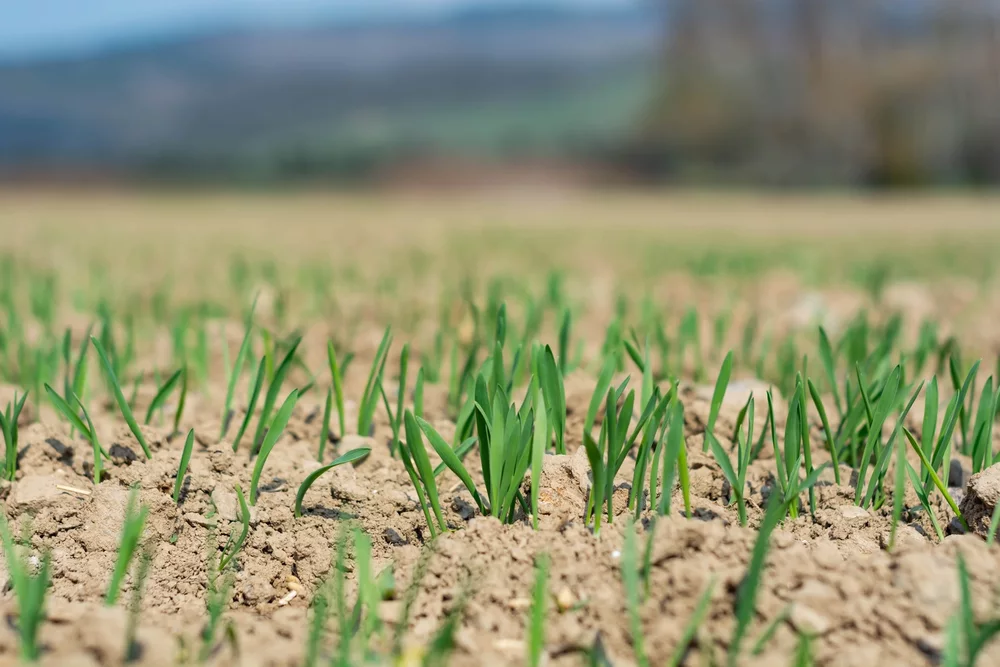 Many people think that using sand is simple and it is okay to spread it all over the lawn anytime. But you can’t use sand on your lawn any time. You have to do some preparation and then use sand as the top dressing. Let’s first learn what you will need for the entire process.
Many people think that using sand is simple and it is okay to spread it all over the lawn anytime. But you can’t use sand on your lawn any time. You have to do some preparation and then use sand as the top dressing. Let’s first learn what you will need for the entire process.
- Sand
- Topsoil Mix
- A spade
- Mulch
- Grass seeds
Once you have collected all the things and are ready to use sand, you can start. For that, just follow the below steps sequentially.
Step 1: Check The pH Level of the Soil
At the beginning of the process, you must learn about the lawn soil’s condition. And checking out the pH of the lawn soil is the best idea. It is essential to understand exactly how much soil you need to use. Normally, sand is good for improving the pH of the soil. And you will need around 25 kilograms of sand for 450 square feet of yard. If the pH is higher, you shouldn’t use sand at all.
Step 2: Loose the Top-Layer
At this point, you have to loosen the top layer of the lawn. You can use a spade and open up the top layer of the lawn. It will help you spread the sand evenly. The sand will have space to be placed unless it covers the roots and damages the entire system.
Step 3: Mow The Grass
 Now, you have to mow the lawn and cut the grass shorter, like 3 inches. Small grass will be easy to work on. Also, when mowing, you should remove debris, thatch, weeds, or other trash. Besides, after mowing the grass, you have to collect the clipping and make space for sand.
Now, you have to mow the lawn and cut the grass shorter, like 3 inches. Small grass will be easy to work on. Also, when mowing, you should remove debris, thatch, weeds, or other trash. Besides, after mowing the grass, you have to collect the clipping and make space for sand.
Step 4: Mixing Time
Now, you must mix 70% of sand and 30% topsoil to make a pro[per top dressing. As sand doesn’t contain any chemicals, it’s not harmful to the grass. However, this mixture won’t kill moss, but it can prevent the growth of moss as moss hates sandy surfaces.
Step 5: Spread The Mixture On the Lawn
Now, spread the top dressing on the lawn evenly. If you have a large lawn, it is better to use a suitable broadcast spreader. For a small size lawn, you don’t need it. You can use a handheld spreader or just spread it with your hand. Try to keep the layer as thin and even as possible. But make sure to spread the sand evenly.
Step 6: For Fixing Holes
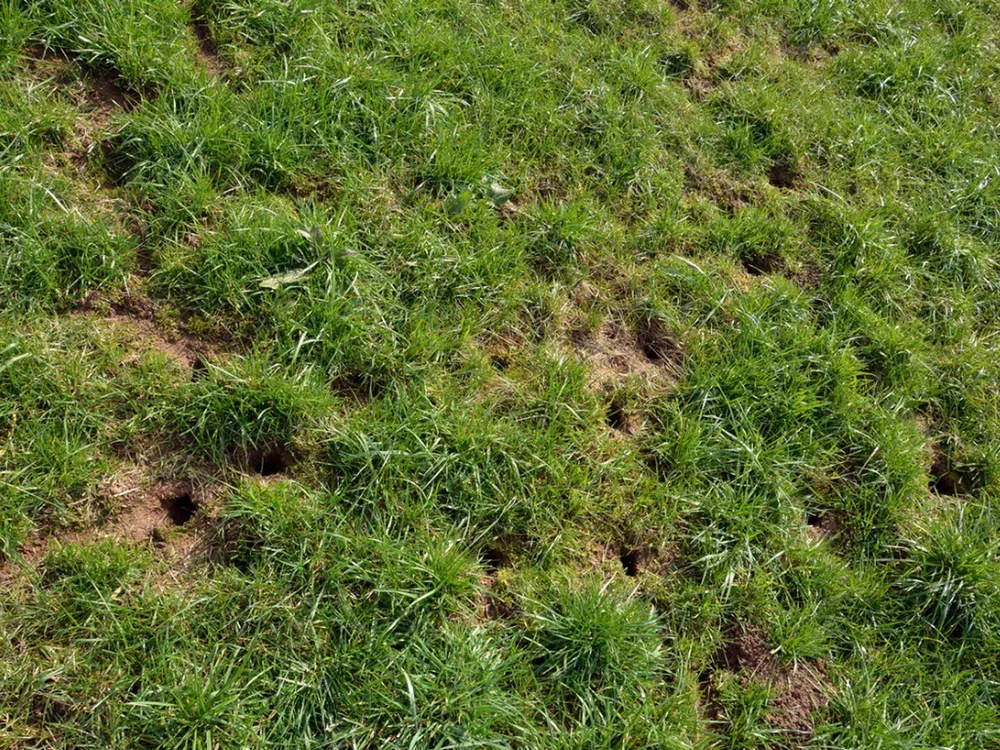 Do you have holes in your lawn here and there? If yes, you can use sand in this case. Mix 50% of the sand and 50% of the topsoil to fill the holes. Now, use the mixture to fill the hole evenly until it’s at the level of the ground.
Do you have holes in your lawn here and there? If yes, you can use sand in this case. Mix 50% of the sand and 50% of the topsoil to fill the holes. Now, use the mixture to fill the hole evenly until it’s at the level of the ground.
Step 7: Overseed the Lawn
Researchers find out that overseeding the lawn after spreading helps it grow thicker. If you want the lawn to be thicker and more beautiful, you can do it as well. For that, just sprinkle the grass seeds on the bald patches. Also, though on the entire lawn evenly.
Step 8: Water the Lawn
Lastly, water the surface enough to keep the lawn moist. It is essential to make the sand settle properly. Otherwise, it will blow up with the wind. So, make sure to start your sprinkler and water the lawn properly. You can make a DIY sprinkler at home if you don’t have one. However, use a hose if you don’t have one.
So, this is the way you can use sand as the top dressing. Make sure to open up the top layer before you mow the lawn and then collect the clippings to clean the lawn. Also, water the lawn thirty minutes after you use sand.
FAQ
Q: What type of sand is the best for the lawn?
A: Sharp sand is the best type to use on the lawn as a top dressing. Lawn owners often use this kind of sand as a top dressing on their lawns, especially when their lawn soil has lower pH. Sharp sands are coarse, washed, and lime-free. Plus, it improves the drainage and aeration system.
Q: Does grass grow through the lawn sand?
A: Yes, any type of grass can grow through the lawn if it’s properly fertilized and watered. Some grass can struggle through the sand only if the ground has clay or sandy soil. It’s because they can’t hold moisture longer, and the grass doesn’t get nutrition from the soil. But if you put a very thin layer of sand, it won’t be a problem.
Q: Does sand burn the lawn?
A: No, sand doesn’t burn the lawn grass if used properly. If you use too much sand on the ground, it’ll be more likely to stick to the roots of the grass, causing damage and later killing the grass. But there is no way sand can burn the grass.
Q: What is the purpose of using sand in lawns?
A: The main purpose of using sand on the lawn is to prevent moss and thatch growth. Preventing the weeds and moss, the sand makes a smooth and neat-looking lawn with lush green grass. Also, it is essential to ensure proper water drainage.
Q: How much sand do I need to use as lawn top dressing?
A: You will need 25 kilograms of sand to cover a 450 square feet lawn. You can measure your lawn size to find the exact amount of sand you need to cover your ground.
Final Verdict
I am sure that you now have enough idea about how to spread sand on the ground. Make sure to follow the steps sequentially and water it immediately after spreading the sand. Otherwise, it may not be stable and blow up when it rains.
No doubt that there are lots of benefits to using sand for lawns. So, if it is time to use a top dressing, you should mix sand with topsoil to use it on the lawn. But make sure to make not more than 2 inches of the sand layer. Hopefully, you will get a lot of benefits from that.
Now, tell me if you have used sand on your lawn before. Did that work well on the lawn? You can share all your opinion about sand as the top dressing. Don’t forget the share if you have any tips for us. Thank you.
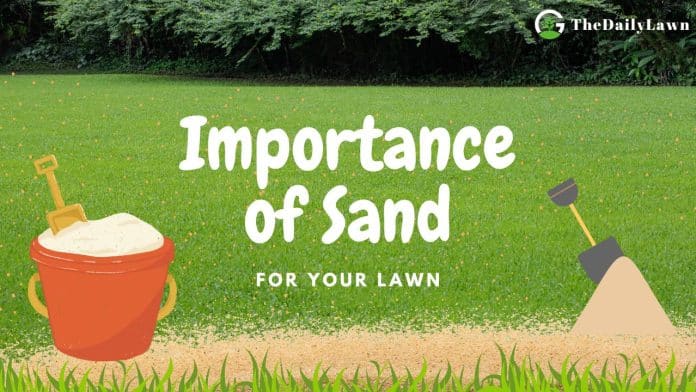
It’s great that you pointed out how sand could make places in compact soil for water circulation. Our lawn doesn’t look good right now, so we are planning on having it renovated. But before we could do that, we need to get some sand supply first.